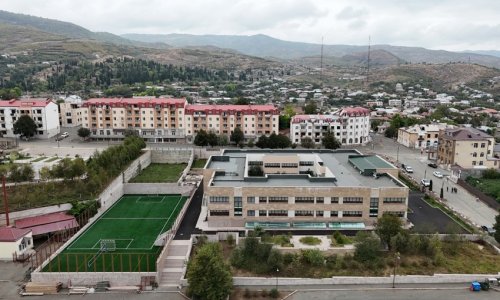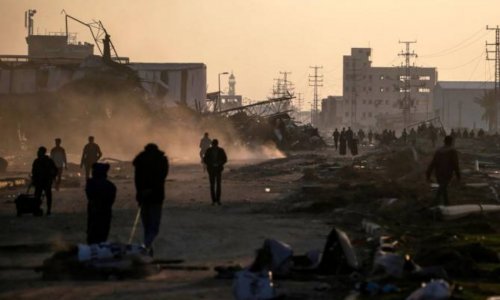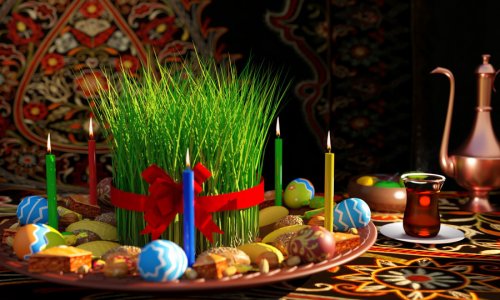By Peter Tese
The Julfa region of the Autonomous Republic of Nakhchivan is the home of the Alinjagala Castle that rests atop the mountain that bears the same name.
The fortress is located on the right banks of the Alinjachay, and according to ancient sources this historic landmark has been identified with the names of: "Erinjag”, "Erinjik”, "Alanjik”, "Alinja”, "Alanjug”. For Basrad Pashayev, a local scholar and journalist, the name of Alinjagala is related to the old Turkish word "alan” having in mind the meaning of "plain land” that is because of the location where the castle was built which happens to be flat. "Alinjak” means "taking off your hand”, it is also related with the invincibility of the fortress. There are various versions about the construction of Alinjagala.
Rui Gonzales Clavico, the ambassador of Henry III, King of Castilla, as a Spanish diplomat to the government of Teymurilar in 1403 – 1406 describes Alinjagala with the following: "Alinjagala is situated on a high and precipitous mountain surrounded by walls and towers. Within the walls, towards the mountain slopes down there are vineyards, gardens, cornfields, springs and pools. Based on ancient historical sources the castle was built over two thousand years ago. Other historians explain that the castle was built on the period of Sasani Government during the III and VII centuries. According to middle age sources, Alinjagala was described as a strong fortification and Alinja was considered as a fortress, mountain and river. Various historians such as Asoghik (928-1019), Sharafaddin Ali Yazdi (XV Century), Evliya Chelebi (XVII Century) and others have widely written about Alinja. The extraordinary view of the Alinjagala (Alanjik) fortress attracts many foreign visitors. It is the symbol of strength, military strategy and for centuries has been a critical geostrategic castle. The walls of Alinjagala castle begin from the slopes of the Alinja Mountain and rise until fully embracing the top of the mountain. Its foundations were built of big stones and burned bricks brought from the nearby villages. Three walls with half round towers remain in the eastern slope and in the west slope remain the ruins of eight walls. One of the fortress walls originates from Khanagah Village on the paths to the fortress there were built guard houses, trenches, and towers for defense purposes. Alinjagala consists mainly of three large areas, East, Northwest and Southwest. There were built stairs to cross from East to North West and South West. The robust fortress walls and the precipitous cliffs have made this castle an invincible place of regional defense. The inner organization of the castle had a town with the ruins of houses and administrative buildings in which there lived for years the fortress chiefs and local feudal class which named this landmark the "shah throne”.
Autonomous Republic of Nakhchivan
Autonomous Republic of Nakhchivan in Azerbaijan.
The residences and houses that belonged to feudal families have been described extensively in the XIX century world literature. There it was possible to keep herds of horses and cattle; it accommodated more than 600 knights and additional military ammunition in many sectors of the fortress. Over thirteen ponds were dug in different points of the hill top and in the rocks are engraved special drawings.
Archeologists have found different natural paintings and animal drawings including: birds, gazelles, deer, snakes, fish and others. The main designs of glazed tableware consist of geometric fragments. In the castle’s territory were found pale green table wares brought to Azerbaijan from China through the great Silk Way.
During the administration of Atabaylar-Eldanizlar in Azerbaijan, Alinjagala acquired a higher importance because various families of the rulers were sheltered there during emergencies. The residence of Zahida Khanum, ruler of Nakhchivan and the treasure of Eldanizlar were in the Alinjagala fortress. In the XIII and XIV centuries Alinjagala was under the rule of Hulakular and in the second half of XIV century was under the administration of Jalairilar. During most of the XIV Century, Alinjagala became the most strategic castle and stronghold for the people of Azerbaijan while waging war against Teymur and defended the region for over 14 years.
The sultan of Jalairi, Ahmad, when he heard of the trail of Teymur, left his treasure, family and close associates in the Alinjagala castle and left for Baghdad. At this time there were about 300 soldiers inside the walls of the castle. In 1386-1401 Teymur attacked Alinjagala four times. In his first attack there was a deadly war around the fortress causing the loss of the lower trenches of the castle which was encircled by the son of Teymur, Miranshah. The defenders, due to the lack of fresh water, were obliged to surrender the castle. However, immediately before abandoning their positions it begun to rain heavily and the defenders decided to maintain their defense positions.
In 1397 Shaki and Georgian army units attacked Alinjagala and defeated Sultan Sanjar, the leader of Teymuri and broke out Sultan Tahir’s encirclement and sent him to Baghdad. For some time Seyid Ali, Haji Saleh and three Georgian leaders headed the defense of the fortress — meanwhile Teymur became worried about Alinja. Under the leadership of five emirs, army units were sent to Alinjagala and the castle was ruled by the leadership of Teymur until his death in 1405.
In the early XV Century Alinjagala passed under the control of Jalairilar and afterwards under the control of Garagoyunlular. The ruler of Garagoyunlu, Isgandar who was fighting against his brother Jahanshah was sheltered in Alinjagala. Later, the castle was under the control of Aghgoyunlular and was subsequently controlled by Safavilar until it was destroyed due to internal and feudal conflicts.
For all those history aficionados who are visiting Azerbaijan, Alinjagala is one of those places that is hard to miss and considered to be very impressive for its strategic position and the role that it played during the last two millennia. The current Government of Azerbaijan has given a special importance to the preservation of the Alinjagala Castle, an archeological and historical location that has earned a special place in world history and is perhaps the most important castle in the cultural heritage of Eurasia.
Sources:
Ibrahimov J. The Essays about XV century history of Azerbaijan (1958)
Mammadov, R. A. "The Middle Ages History of Alinjagala; Materials about Azerbaijan History, Volume IX (1973)
Mammadov, R. A. "The Historical Essay of Nakhchivan City” (1977).
Special thanks to Mr. Hasan Pashali for sharing valuable information in the shaping of this article.
www.ann.az
Follow us !











